
A trefoil is a graphic form composed of the outline of three overlapping rings, used in architecture, Pagan and Christian symbolism, among other areas. The term is also applied to other symbols with a threefold shape. A similar shape with four rings is called a quatrefoil.
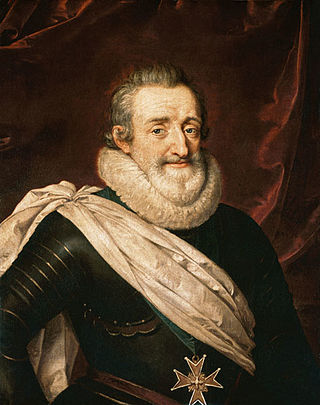
The Edict of Nantes was signed in April 1598 by King Henry IV and granted the minority Calvinist Protestants of France, also known as Huguenots, substantial rights in the nation, which was predominantly Catholic.

The Huguenots were a religious group of French Protestants who held to the Reformed (Calvinist) tradition of Protestantism. The term, which may be derived from the name of a Swiss political leader, the Genevan burgomaster Besançon Hugues (1491–1532), was in common use by the mid-16th century. Huguenot was frequently used in reference to those of the Reformed Church of France from the time of the Protestant Reformation. By contrast, the Protestant populations of eastern France, in Alsace, Moselle, and Montbéliard, were mainly Lutherans.
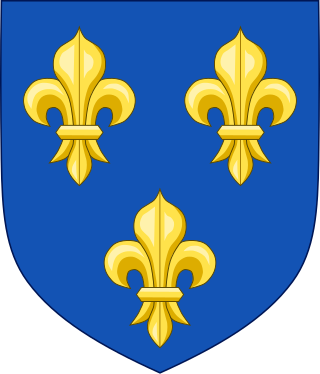
The fleur-de-lis, also spelled fleur-de-lys, is a common heraldic charge in the shape of a lily. Most notably, the fleur-de-lis is depicted on the traditional coat of arms of France that was used from the High Middle Ages until the French Revolution in 1792, and then again in brief periods in the 19th century. This design still represents France and the House of Bourbon in the form of marshalling in the arms of Spain, Quebec and Canada, for example.

The flag of Quebec, called the Fleurdelisé, represents the Canadian province of Quebec. It consists of a white cross on a blue background, with four white fleurs-de-lis.

The original coat of arms of New Brunswick was granted to New Brunswick by a Royal Warrant of Queen Victoria on 26 May 1868. The provincial flag is a banner of the arms.
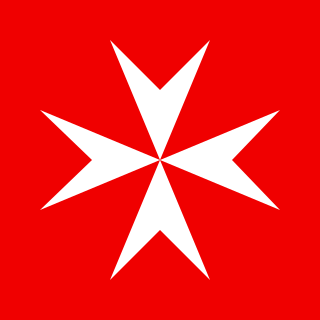
The Maltese cross is a cross symbol, consisting of four "V" or arrowhead shaped concave quadrilaterals converging at a central vertex at right angles, two tips pointing outward symmetrically.

The Huguenot Monument in Franschhoek, Western Cape, South Africa, is dedicated to the cultural influences that Huguenots have brought to the Cape Colony after their immigration during the 17th and 18th centuries. These French and Belgian Protestants were fleeing violent religious persecution, especially in Roman Catholic France.

A cross pattée, cross patty or Pate, or cross paty, also known as a cross formy or cross formée, is a type of Christian cross with arms that are narrow at the centre, and often flared in a curve or straight line shape, to be broader at the perimeter. The form appears very early in medieval art, for example in a metalwork treasure binding given to Monza Cathedral by Lombard queen Theodelinda, and the 8th-century lower cover of the Lindau Gospels in the Morgan Library. An early English example from the start of the age of heraldry proper is found in the arms of Baron Berkeley.

Santa Venera is a town in the Central Region of Malta, with a population of 8,834 (2021). It is located between the towns of Birkirkara and Ħamrun, and it also borders Qormi and Msida.

The first coat of arms of Montreal was designed by Jacques Viger, the first mayor of Montreal, and adopted in 1833 by the city councillors. Modifications were made some one hundred five years later and adopted on 21 March 1938, and again on 13 September 2017, resulting in the version currently in use. The coat of arms was the only city emblem representing Montreal until 1981, when a stylized logo was developed for common daily use, reserving the coat of arms for ceremonial occasions.

The anchored cross, or mariner's cross, is a stylized cross in the shape of an anchor. It is a symbol which is shaped like a plus sign depicted with anchor-like fluke protrusions at its base. There are many variations on this symbol, but the most common form connects a ring with a bar, with a cross-bar, terminating on the other end with two curved branches or arrowheads. The anchor symbolizes hope, steadfastness, calm and composure. It also can symbolize security in one or more uncertain experiences of life, such as sea voyages, one's fate after death, and the vagaries of fortune.

The Order of the Holy Spirit, is a French order of chivalry founded by Henry III of France in 1578. Today, it is a dynastic order under the House of France.
Dieppe Bay Town is a town in Saint John Capisterre Parish in the island of Saint Kitts, in the country of Saint Kitts and Nevis in the West Indies.
The people and province of Quebec have created and established several symbols throughout Quebec's history to represent the collective identity of its residents. Many of Quebec's symbols are related to its history, to catholicism, to Quebec's winters and/or the fauna and flora of Quebec. The motif most commonly seen in Quebec's various symbols is the fleur de lys, which is associated with the French language and New France.

Many people of European heritage in South Africa are descended from Huguenots. Most of these originally settled in the Cape Colony, but were absorbed into the Afrikaner and Afrikaans-speaking population, because they had religious similarities to the Dutch colonists.

Krzyż harcerski is the emblem of Polish Scouting, awarded to Polish Scouts, Senior Scouts and Rangers. It was first used by an underground Scouting organization in Warsaw in 1913. The initial design by Kazimierz Lutosławski has not been modified substantially since then. It is worn on a Scout uniform, over the heart, two fingers above the left pocket.
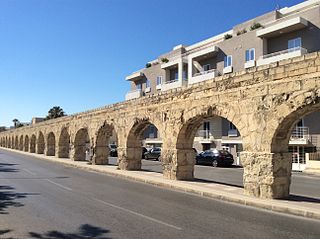
The Wignacourt Aqueduct is a 17th-century aqueduct in Malta, which was built by the Order of Saint John to carry water from springs in Dingli and Rabat to the newly built capital city Valletta. The aqueduct carried water through underground pipes and over arched viaducts across depressions in the ground.
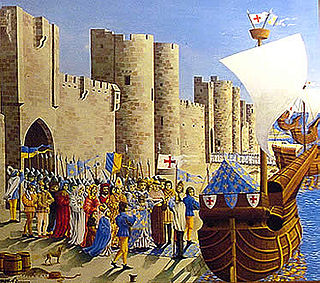
The history of Christian flags encompasses the establishment of Christian states, the Crusader era, and the 20th century ecumenical movement.

The coat of arms of Lyon, the ancient capital of the Gauls, reflects the rich history of the city across different periods of its existence and the power that has exercised authority over the city. It was created in 1320, although the current version, which dates from 1859, reprises the form that it had before the end of the Ancien Régime after having undergone several temporary modifications.




















